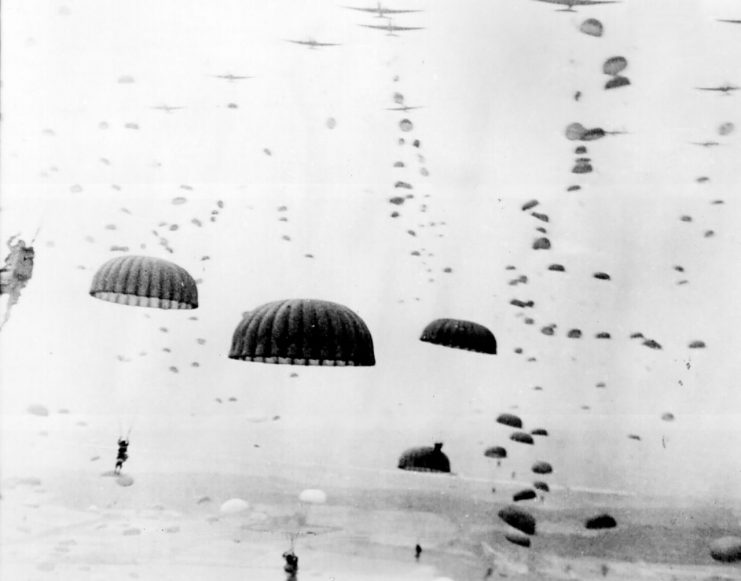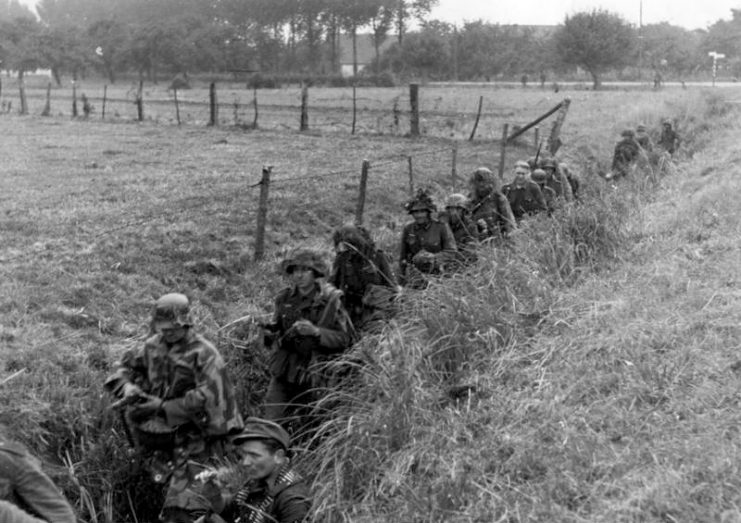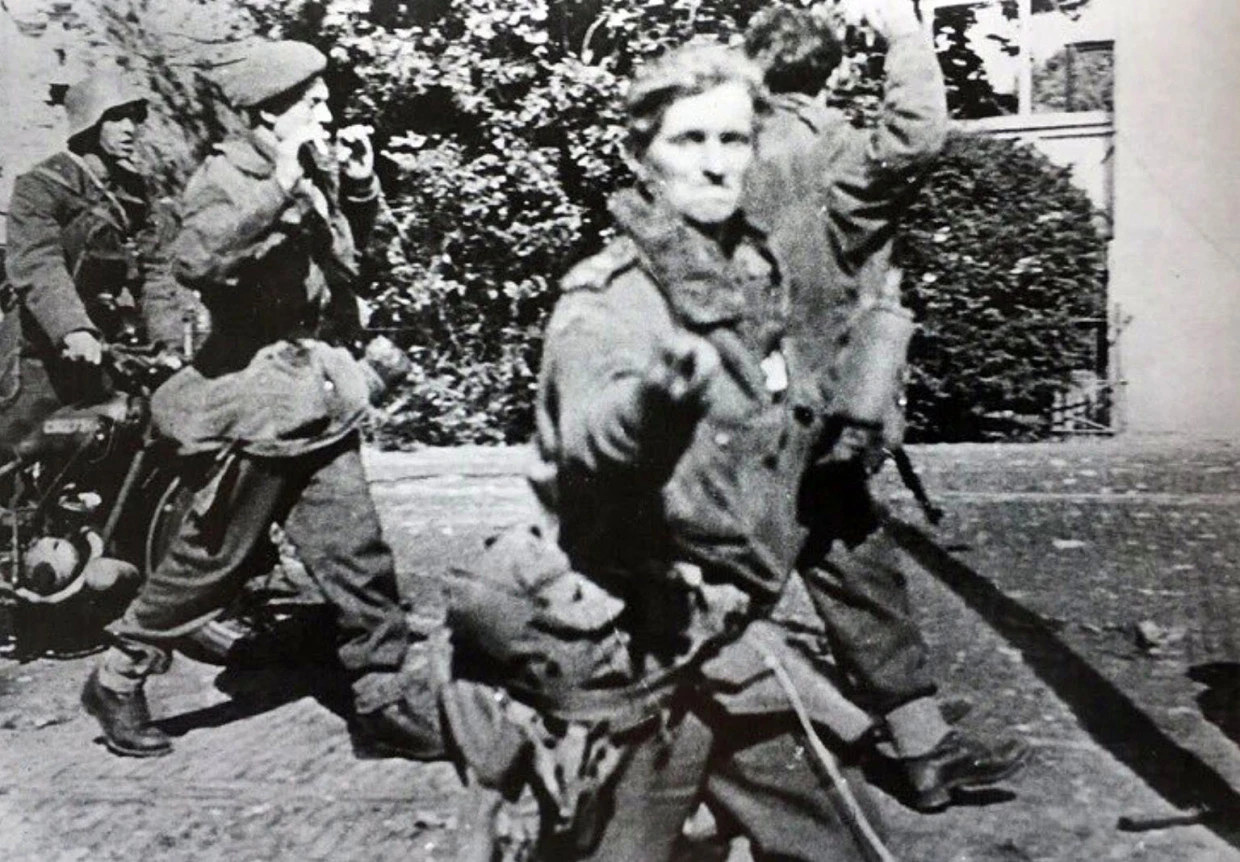Lt. Jack Reynolds has died in his sleep at the age of 97. He was famously photographed after being taken prisoner during the Battle of Arnhem.
In the photo, he is seen giving the “two-fingered” salute to the German photographer. The British hand gesture is an offensive gesture similar to the middle finger in other countries.
He said: “I was so angry at the loss of fine young men and the carnage. Down the road I saw a German chap with a camera and a huge grin on his face and I thought what a b*****d and gave him the opposite ‘V’ sign’.
In September 1944, 1000’s of British airborne troops landed behind enemy lines in Holland. They were overrun by the Germans and taken prisoner. Reynolds saw the photographer filming the captured Brits with a grin on his face. Reynolds was offended by the photographer’s reaction after all the destruction and loss of life in the war, so he flashed the gesture.
He called the defiant moment “a momentary lapse of military judgement” but felt that it was justified at the time.

Reynolds was in a prisoner of war camp in Brunswick, Germany, until April 1945 when the camp was liberated by American forces. From there he went home.
Once home, Reynolds met Eulalie Willcocks, the younger sister of his commanding officer, Captain AH Willcocks. The two men had been in the Brunswick camp together. Jack and Eulalie were married until she died thirteen years ago.
Desperately sad news has reached us so close to the 75th anniversary of the passing at 97 of Lt. Jack Reynolds MC who fought with 2/South Staffs in 1944. Jack gave us one of the most iconic Arnhem images as a POW when he gave the German photographer the two fingers.
RIP. pic.twitter.com/yRMi7ZX4yd— Arnhem Fellowship (@Arnhem44Fellow) August 23, 2019
Reynolds was born in Chichester. He lied about his age in order to join the army at 17. His brother had already joined.
Reynolds trained as a signaller with the Sussex Yeomanry. When his actual age was discovered, he was sent to South Wales to receive additional training rather than sent to battle in France with the rest of his unit.
Reynolds eventually joined the Royal Artillery. He manned a 12-pound gun in Dover which was used to shoot German E-boats in the English Channel.
Reynolds then served in the 1st Airborne Division where he was part of the invasion of Sicily in July of 1943. He received the Military Cross for his actions in that battle.
On September 17, 1944, Reynolds was in the first wave of glider borne troops to join the Battle of Arnhem. He took a motorbike to scout out the enemy.

He was able to locate German infantry and tanks before returning to report to his battalion headquarters.
The next day, the troops were marching towards Oosterbeek when they came under heavy fire from the German tanks. Reynolds moved on alone in order to scout the enemy. He became cut off and spent several days behind enemy lines.
When he was finally able to get back to battalion headquarters, he found that it had been captured by the Germans and the British troops had been forced to surrender.
*Remember Para Lt R at Arnhem * [ and never Bloody Sunday L/Cpl F or LTC W ]; War hero Jack Reynolds who famously flicked a V-sign at the Germans dies aged 97 https://t.co/KMXuim3J9U via @MailOnline
— Tom Carew (@tmcarew) August 30, 2019
Steve Penticost is a historian who interviewed Reynolds for his book “Military Voices: West Sussex Veterans in the 20th Century.” He called Reynolds a man with an “indomitable spirit” who rarely showed any sign of weakness.
According to Penticost, Reynolds never considered himself a hero for his role in the war. Reynolds simply felt that he was doing what needed to be done. In fact, Reynolds could never go back to Arnhem to face the people there. He felt he had let them down due to the reprisals they faced after the battle for the help they gave to the British troops.
The Battle of Arnhem was part of Operation Market Garden, Field Marshal Bernard Montgomery’s daring plan to hasten the collapse of the Third Reich and possibly end the war in 1944.
In part due to missed intelligence about the location of a nearby Panzer squad and in part due to congestion on the single narrow road to Nijmegen and Arnhem, the only 1st Airborne unit to reach the vital Arnhem bridge over the Rhine fought to hold it for four days without the expected assistance from the other British units who were all pinned down by German Panzers.
Another Article From Us: Mystery of Napoleon’s Favourite General May be Solved in Russian Discovery
10,000 British men landed at Arnhem, 1,400 were killed and 6,000 were captured. Only 2,400 escaped in rubber boats across the river.
Market Garden is considered a military disaster popularly referred to as “a bridge too far.”
